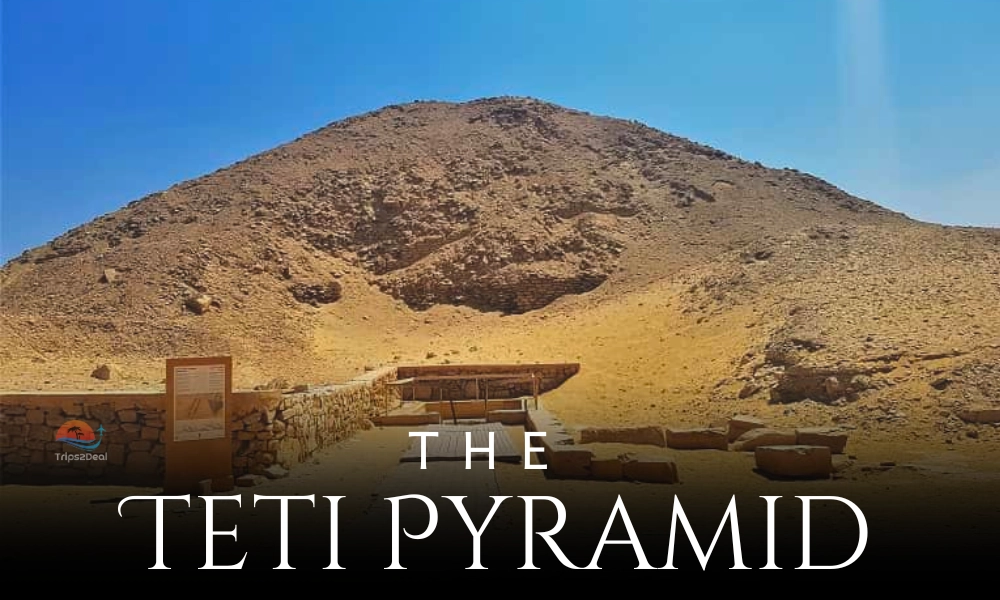Blogs

Teti Pyramid
The Teti Pyramid is situated on a desert plateau called Saqqara, immediately south of the present-day Cairo. Smaller and more destroyed than the renowned pyramids at Giza, it is considered a shift in royal funerary customs. It was constructed to house the tomb of King Teti, the first king of the Sixth Dynasty in Egypt (Old Kingdom). It is composed of a small pyramid along with a large mortuary complex, large burial rooms, and a cemetery of some of the highest officials in Egypt, whose tombs not only inform us about their daily lives but also about their royal authority.
Table of Contents
Who Was Teti?
Teti was the successor to the Fifth Dynasty and contributed to stabilising Egypt when the administration was growing and the power of non-royal elites was increasing. His reign solidified traditions that characterized the late Old Kingdom, such as the system of provincial governors, and the prosperity of the private tombs surrounding royal complexes.
Setting and Layout
The pyramid of Tieti supports a strictly developed complex at North Saqqara. Coming along the Nile valley, there was a causeway that used to unite a valley temple (near the edge of cultivation) with a mortuary temple on the east side of the pyramid.
On the complex are pyramids and chapels of queens and members of the royal family, averaging small in scale, and mastabas of top officials, the largest being the great mastaba of Mereruka, the much-carved reliefs on which show shops, fishing, music, and ceremony in minute detail.
Construction and Appearance
The pyramid of Teti is not huge like the ones of the Fourth Dynasty. It was constructed of local limestone blocks and rubble and covered with fine Tura limestone. Much of that casing was chiselled away over millennia to give a profile of a low, eroded mound instead of a sharp pyramid shape.
Nevertheless, the Old Kingdom engineering rationale is evident in the form of a north-side entrance that is followed by descending passages, security barriers and a series of chambers running east or west.

Inside the Pyramid: Texts, Stars, and a King’s Afterlife
The burial chambers of Teti mirror the most powerful religious invention of ancient Egypt, the Pyramid Texts. These spells and invocations were inscribed in the walls in sharp vertical columns..
You find the ceiling of the chamber will often be carved and painted with stars, and five-pointed ones, and this makes the chamber a sort of microcosm of the night sky. The king was buried in a dark stone sarcophagus, with ritual equipment being kept in side rooms.
Queens, Family, and the Court
The complex of Teti has subsidiary pyramids of queens and royal women, which highlights the way in which family piety and royal authority overlapped. Close by, the tombs of dignitaries like Mereruka and Kagemni are superb specimens of Old Kingdom style.
Their reliefs are encyclopedias of elite life-boating, hunting, craft production, and accounting, and project a sharp contrast to the royal texts in the pyramid itself. Together, they represent a society in which administrative knowledge and provincial authority were on the ascending side with royal power.
What Makes Teti’s Pyramid Important?
Religious turning point: Pyramid Texts begin to be used widely within royal tombs, which becomes standard in the Sixth Dynasty and leads to the Coffin Texts and the Book of the Dead.
Stone social history: The adjacent cemetery gives a unique image of life at the court, occupation and the sense of style.
Architectural development: The pyramid of Teti demonstrates the way in which architects combined tradition with economy, smaller but less expensive pyramids with excessive interior decoration and ornate temples.
Condition and Excavation: Nowadays, the pyramid of Teti can be seen as a humble one, but the inside inscriptions are still a result of the fascination of the Egyptologists and other tourists. In the recent two hundred years, excavations in and around the complex have illuminated the plan, restored passages and discovered more queens’ pyramids and groups of later burials, evidence that Saqqara was still a sacred topography many centuries later than Teti.
Visiting Tips (for travellers)
- Add it to the must-sees of Saqqara: Add the pyramid of Teti to the Step Pyramid of Djoser and the tombs of Mereruka and Kagemni to get the whole story of the Old Kingdom in a day.
- Stick to a guide: An Egyptologist guide with a license will draw your attention to certain features of the site, such as particular pyramid text spells or unusual relief images.
- Be aware of desert factors: Shoes, water, and sun protection are all necessities; entrance to the site and chamber openings may change with season.
Conclusion
The Teti Pyramid is not a question of excess scale, but of the complexity of faith, the emergence of the bureaucracy of the royal court, and the development of the art of the Old Kingdom of Egypt. Enter its chambers with their starry pavement, survey its mortuary temple remains, and loiter in the surrounding mastabas, and you will know why this small monument remains at the centre of our knowledge of the ancient Egyptian religion, kingship, and the life of the elite.




